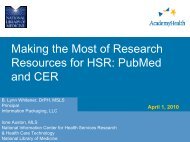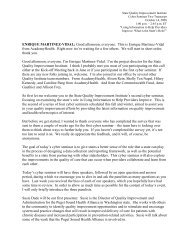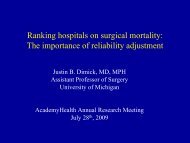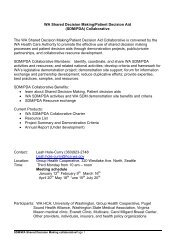Ohio Health Quality Improvement Plan
Ohio Health Quality Improvement Plan
Ohio Health Quality Improvement Plan
You also want an ePaper? Increase the reach of your titles
YUMPU automatically turns print PDFs into web optimized ePapers that Google loves.
Appendix IV — Co m m e n t s f r o mStatewide Or g a n iz a t io n sinitial efforts on tactics within two of the strategies thatwe believe offer the most immediate opportunities fortransforming our system. Those two strategies are (1)payment reform, including moving away from fee-forservicereimbursement and towards a more comprehensive,risk-adjusted payment system that incentivizes health careproviders to reduce the highly fragmented nature of ourcurrent delivery system (through, for example, accountablecare organizations or other vertically integrated modelsthat include medical homes to coordinate care, especiallyamong patients with multiple chronic conditions), and (2)catalyzing more rapid adoption of electronic health recordsas part of integrated health information systems.The <strong>Ohio</strong> Business Roundtable stands ready to commitits time, talent, and resources to ensure the success ofthe Council and the plan – and we hope our partnersin developing the plan will continue to invest theirfull energies toward the common vision and principlesidentified in the plan for transforming <strong>Ohio</strong>’s health system.<strong>Ohio</strong> Chamber of CommercePatient Centered Medical HomesA Patient Centered Medical Homes (PCMH) model issomething that <strong>Ohio</strong> should strive to adopt. Encouragingpatients to develop a continuous relationship with a healthcare provider can enhance patient care and help ensurequality of care and reduce cost in the system. Employersshould be considered an integral part of the PCMH Taskforce in order to encourage the widespread use of PCMHsin our current employer based health care system. Toensure that the adoption of PCMH does not simply layeradditional cost on the system, the state should be mindfulthat a PCMH does not necessarily need to be a physician,other health care providers may be a more appropriatehome for coordination of care and other functions ofa PCMH. Also, adoption of a PCMH model does notnecessarily equate to more physicians; in fact a wellrespected research group The Dartmouth Institute for<strong>Health</strong> Policy and Clinical Practice just commented on thisvery issue. At this early stage, it seems appropriate that thestate could first implement this approach with the Medicaidpopulation, which amounts to about 13 percent of <strong>Ohio</strong>ansand focus the PCMH approach on those with chronicconditions first.<strong>Health</strong> Information Technology<strong>Health</strong> Information Technology (HIT) is going to benecessary if <strong>Ohio</strong> is going to move forward in reformingour health care system. There have been many advances inthe area of HIT in the past few years. A number of payershave adopted or are in the process of adopting IT systemsthat can process claims quicker and more efficiently, allowpatients access to claims on-line and use electronic tools tohelp educate patients about disease prevention and chroniccare management. While at the same time, providers arebeginning to utilize other technological advances suchas e-prescribing and personal health records to advancecontinuity and quality of care. Large providers especially,have taken a leading role in the adoption of technology topromote optimal care. But smaller, individual provideroffices are lagging behind in the adoption of suchtechnology that will be necessary to implement several ofthe strategies laid out in this proposal including PCMHs.Further, the state should take care not to duplicate effortstaking place by the private sector. A number of productsare available on the market and while the state should spareno effort to encourage the use of HIT, it should not becompeting with private sector products.Payment ReformArguably the most discussed of the four reform strategies,payment reform, though necessary, is not the silver bulletfor fixing our health care system, but rather a means toachieve the necessary reforms. Through payment reforms,the state can achieve quicker adoption of PCMHs and HIT,but payment reform alone will not address the staggeringincreases in the cost of health care. Payments should focuson “episodes of care” rather than payments for individualservices. In addition, it seems appropriate for the state towork in conjunction with health care providers to developbest practices that include standards of care for commonepisodes or procedures, similar to the Geisinger <strong>Health</strong>System’s ProvenCare program in Pennsylvania.Informed and Activated Patients and IndividualsInformed and active individuals are a critical piece ofthe health care reform puzzle, without such individuals itwould be virtually impossible to reform our health caresystem. In moving to ensure that all individuals becomeinformed and activated, the state must ensure that there isfocus on transparency in all aspects of the care continuum,including incentives for compliance and penalties for noncompliance.37










